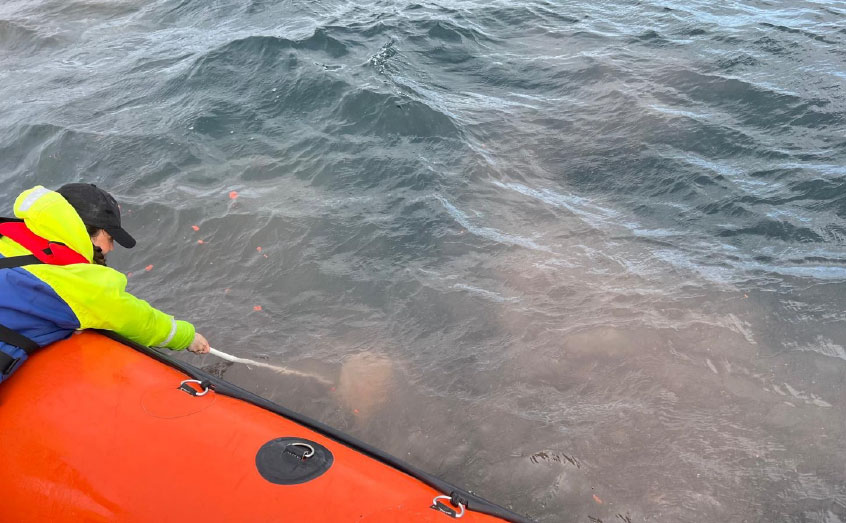SAMS news room
Community scooping whale poop to study the diet of whales in Scotland

Spirits have been high among whale enthusiasts around The Minch in recent years, as larger whale species like fin and humpback whales have been settling in the region. While the smaller minke whale has been commonly seen for many years, the arrival of their larger cousins raises questions about what is sustaining their enormous appetites. “Large baleen whales like fin and humpback whales are choosing to return to the waters around The Hebrides each year to feed, however we don’t yet know what prey species are enticing them inshore”, says Dr Conor Ryan, Honorary Research Fellow at the Scottish Association for Marine Science.
To seek answers, the Wester Ross Fisheries Trust has sought the assistance of a team of mariners who regularly encounter or work with whales: commercial fishers, whale-watchers and scientists. With a grant from the Community Marine Biodiversity Monitoring Project – a partnership between NatureScot, Fauna & Flora and the William Grant Foundation – the crew of six vessels that ply The Minch aims to monitor whale diet by scooping up whale poop using bespoke sampling nets. Dr Texa Sim from NatureScot said: “This research is a wonderful example of a community project playing an important role in monitoring how whales are faring in the Outer Hebrides. Learning what whales eat will, in turn, help us understand how to protect both them and all the vital marine life in their food cycle.”
The discovery in 2024 of bright orange whale poop by Hebridean Whale Cruises crew Steve Truluck and Shenley Lloyd prompted the new research efforts, after they brought a whale poop sample to the Wester Ross Fisheries Trust for analysis. They also photographed humpback whales gorging on krill. Whether it is krill, herring, other prey or all of the above that is feeding the whales has yet to be fully determined. “With the help of the local community, we have been monitoring recently rediscovered herring spawning grounds off Gairloch. In springtime, herring congregate to release spawn onto beds of maerl (coral-like seaweed). The gathering attracts all manner of predators including whales, dolphins and seabirds. The spawning can even be seen from space!”, said Peter Cunningham, Biologist at the Wester Ross Fisheries Trust.
“Scooping whale poop has the potential to unlock some of the secrets that these whales are keeping, by non-invasive sampling”, says Dr Ryan. The goal is to conduct stable isotope analysis on the poop samples to work out what proportions of fish or zooplankton make up the diet of these whales. Without knowing what the whales are eating, it is hard to protect them. The samples can also be used to genetically identify digested prey species and to investigate the degree of plastic ingestion in these whales.
Watch a minke whale defecating as it begins a deep dive off the Isle of Skye, captured by Anthony Rigell: https://youtu.be/TcGOKXN-cQ0?feature=shared
Notes to editors
Conor Ryan, SAMS: miolmor@gmail.com / 07850250156
Peter Cunningham, Wester Ross Fisheries Trust: (info@wrft.org.uk)
Wester Ross Fisheries Trust (WRFT) was established in 1996 in response to the need for solutions to fisheries problems and to improve the management of wild fisheries. The seas around Wester Ross once supported a major herring fishery, with Ullapool once the largest herring port in the UK. The fishery collapsed in 1970s owing to over-fishing. Recent monitoring efforts and a report on the work of WRFT and the links between herring spawning and predators can be read here.
The last known attempt to study the diet of fin and humpback whales comes from a report by Robert Clark when in June 1951 he studied the stomachs of several whales killed to the west of the Outer Hebrides and landed at Scotland’s last operational whaling station at Bunavoneadar, Isle of Harris. A recent paper reported that close to 10,000 whales were killed in Scottish whaling stations, mostly fin whales.
The Hebridean Whale and Dolphin Trust has an app and website for reporting sighting records of whales around Scotland. Viewers can see and map what others have reported. The Scottish Humpback Whale Catalogue project, managed by Lyndsay McNeill, solicits photographs of humpback whale tails, so that their unique markings may be used to track whale movements. Please send your photos to Lyndsay McNeill (lyndsaymcneill@icloud.com)
